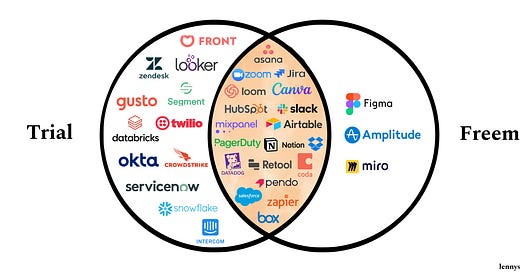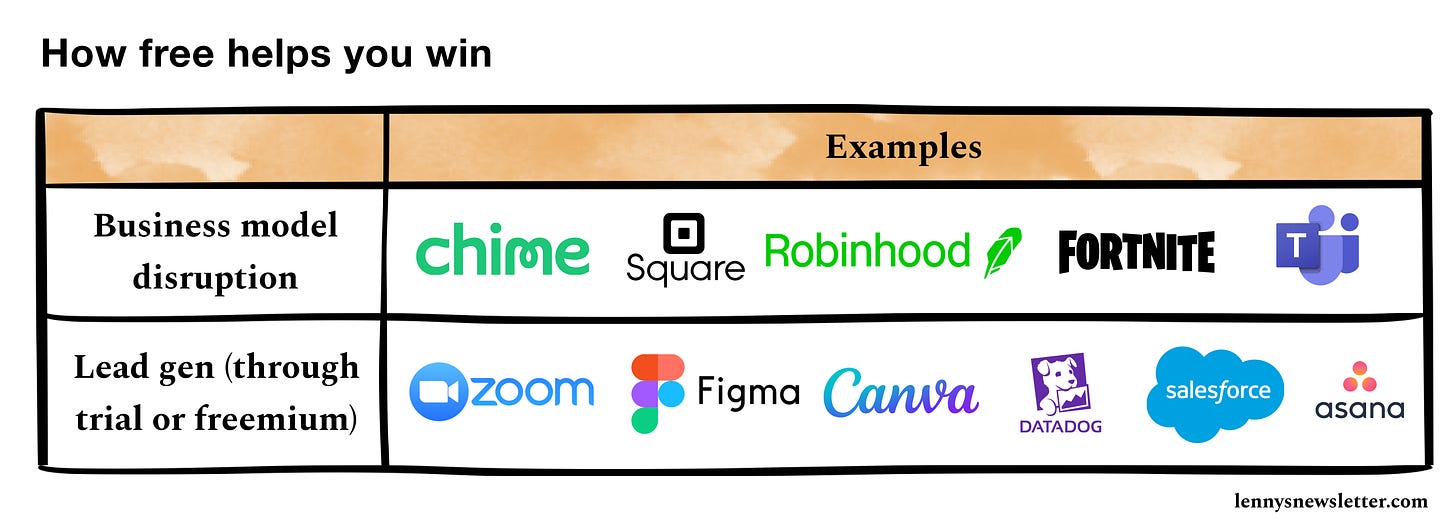👋 Hey, I’m Lenny and welcome to a 🔒 subscriber-only edition 🔒 of my weekly newsletter. Each week I tackle reader questions about product, growth, working with humans, and anything else that’s stressing you out about work. Send me your questions and in return I’ll humbly offer actionable real-talk advice.
Q: When does it make sense to make my product free? And how do I decide between offering a free trial or having a freemium product?
Microsoft Teams came from behind and disrupted Slack’s dominance in workplace chat (145m DAU vs. 12m, respectively) by making its product essentially free (i.e. part of the Office 365 bundle). Robinhood launched the world’s first free stock-trading product and quickly built a waitlist of over a million people, completely disrupting the stock-trading space. And Fortnite generated over $5b just last year by giving its game away for free. Also, if you hadn’t noticed, freemium and PLG are all the rage these days.
Free is the ultimate value prop. I’ve come across only three SaaS products that don’t have a free (or very cheap) offering. Why? Because free, used effectively, helps you (1) get people’s attention, and (2) gives people an incredibly low-friction (e.g. no sales call, no credit card) chance to take your product for a spin. The question isn’t really whether you should give away some or all of your product—you most certainly should. The question is what you should give away for free and how to most effectively use your free offering to drive top-line growth.
Two ways to use free to your advantage
Making a product free isn’t a revenue, pricing, or monetization strategy—it’s an acquisition strategy. It’s always a means to lower CAC, increased virality, and a way to get people’s attention in a crowded market. All in an effort to monetize in some other way.
There are two primary strategies for using free to drive growth:
1. Business model disruption: Giving away the core product while making money in some other way
Chime disrupted the entrenched banking industry by offering fee-free banking—while making money through transaction interchange fees. Robinhood broke out by launching free stock trading—while making money through payment for order flow. Square gave away free PoS systems—as a wedge into taking a cut of SMB transaction flows (and later, lending, banking, payroll, and much more). Making their products free gave these companies a way to break through the noise.
“If it’s digital, sooner or later it’s going to be free.”
—Chris Anderson, Free: The Future of a Radical Price
Find a way to make free a product that is currently not free, and you’ll get a lot of people’s attention.
2. Lead gen: Give prospects a taste of your product (freemium or trial) in hopes that they take a full bite
The more typical way to use free to drive growth is to give potential customers a way to try your product (or parts of your product) for free. This is done with a free trial or a free tier of your product. The bet is that the lower friction of trying out your product leads to more paying customers. As you’ll see below, nearly every SaaS product goes this route.
“I have never come across the business where I don’t believe there’s not a role for free at some point in their strategy.”
—Elena Verna
Find a way to make (part of) your product free, and you’ll most certainly accelerate growth.
For the purpose of this post, I’m going to stick to typical free strategies for SaaS companies, but there are other ways to use “free” to drive growth:
Free samples (e.g. Red Bull)
Free shipping (e.g. Amazon Prime)
Free prize inside (e.g. cereal boxes)
Getting a bonus for signing up (e.g. Uber)
When to go trial vs. freemium
I looked at the pricing models of about 50 SaaS products, and the takeaways are fascinating.






